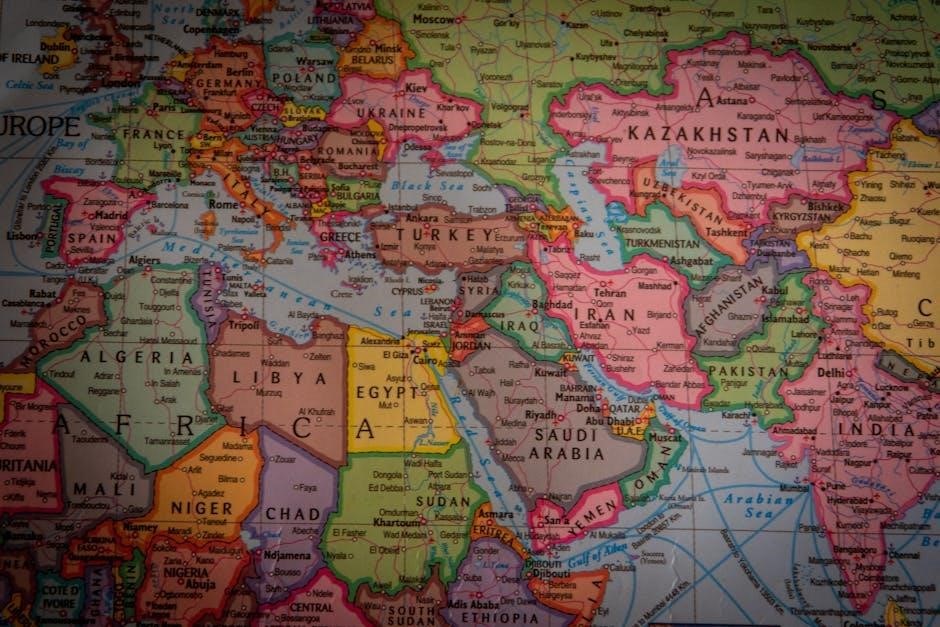The 23rd edition of the Goodes World Atlas offers a comprehensive and updated geographical resource, combining detailed maps with digital enhancements for improved navigation and analysis. Featuring over 300 pages of reference and thematic maps, it covers political, physical, and cultural details, along with environmental data like climate change and sea level rise. GPS integration and interactive tools make it a versatile tool for both physical and digital use, catering to researchers, educators, and general users alike. This edition reflects the evolving needs of modern cartography, blending tradition with innovation.
Overview of the Atlas and Its Significance
The Goodes World Atlas 23rd Edition is a benchmark in cartography, offering a detailed and comprehensive representation of the world’s geography. It combines traditional cartographic excellence with modern digital enhancements, making it a vital resource for geographers, researchers, and educators. The atlas covers a wide range of topics, from political and physical maps to environmental and social data, providing insights into global trends and challenges. Its significance lies in its ability to bridge the gap between physical and digital mapping, ensuring accessibility for both print and digital users. With over 300 pages of maps and data, it remains a trusted tool for understanding the complexities of our ever-changing world. Its relevance extends beyond academia, serving as a valuable reference for anyone interested in global issues and spatial analysis;
Key Features of the 23rd Edition
The 23rd Edition of the Goodes World Atlas introduces several innovative features that enhance its utility and appeal. One of the standout additions is the integration of GPS technology, allowing users to navigate maps with greater precision. The atlas also includes a wide range of thematic maps, focusing on critical issues such as climate change, sea level rise, and CO2 emissions. These maps provide a visual representation of global trends, making complex data accessible to a broad audience. Additionally, the edition offers over 60 new reference and thematic maps, ensuring that the information is both up-to-date and comprehensive. The inclusion of interactive digital tools further enriches the user experience, making the atlas a versatile resource for both academic and practical applications.

Detailed Features of the Goodes World Atlas
The Goodes World Atlas 23rd Edition features color-coded headings and detailed introductions to each section, enhancing readability. It includes reference and thematic maps, providing insights into political, physical, and cultural landscapes. The atlas also incorporates visual elements like photos and charts to present complex data clearly, making it a comprehensive and user-friendly resource for geographers, researchers, and students.
Reference Maps: Political, Physical, and Cultural Details
The Goodes World Atlas 23rd Edition includes detailed reference maps that provide a comprehensive understanding of the world’s political, physical, and cultural landscapes. Political maps highlight international boundaries, capital cities, and key infrastructure, offering insights into global governance. Physical maps showcase natural features such as mountains, rivers, and ecosystems, emphasizing the Earth’s geological diversity. Cultural maps illustrate the distribution of languages, religions, and ethnic groups, enriching the atlas’s narrative with societal context. These maps are color-coded for clarity and include legends and symbols to enhance readability. Together, they form a robust foundation for exploring the complexities of our world, making the atlas an essential tool for researchers, educators, and enthusiasts alike. The attention to detail ensures a seamless blend of information and visual appeal, fostering deeper understanding of global geography.
Thematic Maps: Environmental, Social, and Economic Data
The 23rd Edition of the Goodes World Atlas features an extensive collection of thematic maps, offering deep insights into environmental, social, and economic trends. Environmental maps detail global climate change impacts, sea level rise, and CO2 emissions, while social maps explore population density, migration patterns, and cultural diversity. Economic maps highlight trade routes, GDP distribution, and resource extraction zones. These maps utilize vibrant colors and intuitive symbols to present complex data clearly. By visualizing these dynamics, the atlas provides a holistic understanding of global challenges and opportunities. The thematic maps are particularly valuable for researchers, policymakers, and students seeking to analyze interconnected societal and environmental issues. This section underscores the atlas’s commitment to delivering data-driven insights in an accessible format.
Infographics and Data Visualization
The 23rd Edition of the Goodes World Atlas excels in its use of infographics and data visualization, presenting complex information in an engaging and accessible manner. Charts, graphs, and visual summaries are strategically integrated to highlight key global trends, such as population growth, economic shifts, and environmental changes. These visual tools are designed to complement the maps, offering readers a deeper understanding of interconnected issues. Color-coded headings and intuitive symbols ensure clarity, making the data easy to interpret for both researchers and casual users. The atlas’s commitment to modern design enhances its usability, providing a visually appealing and informative experience. This feature makes the Goodes World Atlas a valuable resource for anyone seeking to explore global patterns and dynamics.

Digital Enhancements in the 23rd Edition
The 23rd Edition introduces GPS integration and interactive maps, enhancing navigation and analysis. Digital tools provide immersive experiences, making the atlas a cutting-edge resource for modern users.
GPS Integration for Improved Navigation
The 23rd Edition of the Goodes World Atlas features GPS integration, revolutionizing navigation capabilities. This advanced tool enables users to pinpoint locations with precision, enhancing both recreational and professional use. Real-time updates and geographic data layering provide unparalleled accuracy, making it indispensable for researchers, travelers, and educators. The integration allows for seamless location tracking and route planning, ensuring users can explore the world with confidence. This feature bridges the gap between traditional cartography and modern technology, offering a dynamic and interactive experience. By incorporating GPS, the atlas sets a new standard for navigational excellence, catering to diverse needs in an increasingly digital world.
Interactive Maps and Digital Tools
The 23rd Edition of the Goodes World Atlas introduces interactive maps and digital tools, enhancing user engagement and analytical capabilities. These features allow users to explore maps dynamically, with options to zoom, layer data, and customize views. Thematic maps on environmental, social, and economic topics are now more accessible, enabling deeper insights into global trends. The atlas also includes data visualization tools to interpret complex information effortlessly. These digital enhancements make the atlas a powerful resource for researchers, educators, and students, providing a modern and intuitive way to study geography. The integration of interactive elements ensures the atlas remains a leading tool for both academic and professional use, blending tradition with cutting-edge technology for a seamless user experience.

Environmental Coverage in the Atlas
The 23rd Edition emphasizes global environmental challenges, featuring detailed maps on climate change, sea level rise, and CO2 emissions. It highlights critical ecological issues with precision and clarity, offering insights into Earth’s evolving landscapes and human impact on the environment.
Global Climate Change Maps and Analysis
The 23rd Edition of the Goodes World Atlas includes detailed maps and analysis on global climate change, showcasing temperature trends, ice melting, and extreme weather patterns. These visuals highlight regions most affected by rising temperatures and sea level rise, providing a clear understanding of environmental shifts. The atlas integrates data from recent studies to illustrate the impact of climate change on ecosystems and human populations. With a focus on CO2 emissions and their geographical distribution, the maps offer a comprehensive view of the challenges facing the planet. This section serves as an essential resource for researchers, educators, and policymakers seeking to address climate change effectively. The atlas’s visual representations make complex data accessible, ensuring a broader understanding of this critical issue.
Sea Level Rise and Coastal Impact Maps
The 23rd Edition of the Goodes World Atlas features comprehensive maps detailing the impact of sea level rise on coastal regions worldwide. These maps illustrate areas at risk of inundation, highlighting vulnerable populations and ecosystems. The atlas provides projections for future sea level rise, offering insights into potential displacement and economic implications. Visual representations of coastal erosion and flooding zones are included, alongside data on saltwater intrusion into freshwater sources. This section is particularly valuable for urban planners, environmental scientists, and policymakers. By combining current data with predictive analysis, the maps offer a critical tool for understanding and mitigating the effects of rising sea levels on global communities and natural habitats. This focus ensures the atlas remains a vital resource for addressing pressing environmental challenges.

Historical Significance of the Goodes World Atlas
Named after its creator, John Paul Goode, the Goodes World Atlas has become a cornerstone of cartography, blending tradition with innovation since its inception. Its legacy reflects the evolution of mapping technology and global understanding, offering a timeless resource for scholars and explorers alike. This edition continues to honor its enduring relevance in the field of geography and beyond.
Legacy of John Paul Goode and the Atlas’s Evolution
John Paul Goode, the creator of the Goodes World Atlas, laid the foundation for modern cartography with his innovative approaches to mapping. Over the years, the atlas has evolved significantly, transitioning from traditional print to digital formats while maintaining its core principles. The 23rd edition reflects this legacy, incorporating the latest advancements in geographic data and technology. Goode’s emphasis on accuracy and detailed representation has been preserved, even as the atlas adapts to contemporary needs. This balance of tradition and innovation ensures that the Goodes World Atlas remains a trusted resource for geographers, researchers, and educators. Its evolution mirrors the changing world, making it a bridge between historical cartography and future discoveries.
Historical Maps and Their Relevance Today
Historical maps in the Goodes World Atlas provide a glimpse into the past, showcasing how territories, cultures, and environments have evolved over time. These maps are not just archival records but serve as vital tools for understanding historical contexts. The 23rd edition incorporates digitized versions of classic maps, ensuring their preservation and accessibility for modern researchers and educators. By comparing historical and contemporary maps, users can trace changes in geopolitical boundaries, environmental shifts, and cultural developments. This feature bridges the past and present, offering insights into long-term trends and patterns. Historical maps remain indispensable for academic research, teaching, and anyone interested in the dynamics of global change. Their inclusion underscores the atlas’s commitment to comprehensive and timeless cartographic knowledge.

Usability and Design of the Atlas
The Goodes World Atlas 23rd Edition features a user-friendly layout with color-coded headings, clear section introductions, and cross-referencing, ensuring easy navigation and comprehensive understanding.
User-Friendly Layout and Color-Coded Headings
The Goodes World Atlas 23rd Edition boasts a user-friendly layout designed for clarity and ease of navigation. Color-coded headings and section introductions guide users through the atlas, ensuring quick access to desired information. This design enhances readability and organization, making the atlas accessible to students, researchers, and casual users alike. The visual appeal of the color-coded system aids in distinguishing between different types of maps and data, while the logical structure helps users transition seamlessly between sections. These features collectively create an intuitive and engaging experience, allowing users to focus on the wealth of geographical data without unnecessary complexity. The atlas’s thoughtful design ensures that its wealth of information is both accessible and easy to interpret.
The Goodes World Atlas 23rd Edition includes concise section introductions that provide context and highlights for each geographical region, enabling users to grasp key themes quickly. Cross-referencing is seamlessly integrated, allowing readers to navigate between related maps and data effortlessly. This feature is particularly useful for comparative analysis and in-depth research. The logical structure ensures that users can move between sections without confusion, while the introductions offer insights into the significance of each area. By combining clear overviews with interconnected references, the atlas enhances usability for both casual browsing and detailed study. This approach ensures that the wealth of information remains accessible and engaging for all users.

Comparisons with Previous Editions
The 23rd edition of the Goodes World Atlas introduces enhanced digital features, expanded thematic maps, and improved cross-referencing, surpassing earlier versions in depth and interactivity for modern users.
Upgrades and Improvements in the 23rd Edition
The 23rd edition of the Goodes World Atlas introduces significant enhancements, including over 300 pages of detailed maps, both reference and thematic, offering enhanced insights. Digital improvements such as GPS integration and interactive tools provide users with advanced navigation capabilities. New thematic maps focus on critical global issues like climate change, sea level rise, and CO2 emissions, offering a deeper understanding of environmental challenges. The atlas also boasts improved design elements, including color-coded headings and section introductions, which aid in easier navigation and comprehension. These enhancements ensure the atlas remains a vital resource for researchers, educators, and enthusiasts, blending tradition with cutting-edge technology to meet modern cartographic demands.
Retention of Classic Features
The 23rd edition of the Goodes World Atlas retains many of its classic features, ensuring continuity and familiarity for long-time users. The color-coded headings and section introductions remain, providing clear organization and ease of navigation. Traditional reference maps, including political and physical details, are still prominently featured, offering a foundational understanding of global geography. Additionally, the cross-referencing system has been preserved, allowing users to seamlessly connect related content. These classic elements maintain the atlas’s legacy while complementing its modern enhancements, ensuring that the edition stays true to its roots. The balance between tradition and innovation makes the 23rd edition both a reliable resource and a forward-thinking tool for geographers and researchers alike.

Educational Value of the Atlas
The Goodes World Atlas 23rd Edition is a valuable educational resource, ideal for schools and academic research. Its detailed maps and thematic data support geographers and researchers, enhancing learning and analysis across various disciplines.
Use in Schools and Academic Research
The Goodes World Atlas 23rd Edition is widely used in educational institutions, providing students and educators with a comprehensive resource for geography and related studies. Its detailed maps and thematic data offer insights into political, physical, and cultural landscapes, making it an essential tool for classroom instruction and academic projects. Researchers benefit from the atlas’s extensive coverage of environmental issues, such as climate change and sea level rise, which are critical for contemporary studies. The inclusion of GPS integration and digital tools enhances its usability, allowing for interactive learning experiences. This edition is particularly valued for its balance of traditional cartography and modern data visualization, supporting both foundational and advanced research in geography and environmental science.
Value for Geographers and Researchers
The Goodes World Atlas 23rd Edition is an invaluable resource for geographers and researchers, offering a wealth of detailed and updated geographical data. Its extensive collection of thematic maps provides insights into environmental, social, and economic trends, enabling in-depth analysis of global patterns. Researchers benefit from the atlas’s focus on climate change, sea level rise, and CO2 emissions, which are presented with precise data visualization. The inclusion of GPS integration and interactive digital tools further enhances its utility for fieldwork and academic studies. For geographers, the atlas serves as a comprehensive reference for understanding both physical and human landscapes, while its cross-referencing system facilitates seamless navigation between topics. This edition strikes a balance between traditional cartography and modern, data-driven approaches, making it an essential tool for professionals and scholars alike.

Availability and Access to the 23rd Edition
The 23rd edition of the Goodes World Atlas is available as a PDF download, ensuring easy digital access for users worldwide. It can be purchased or downloaded from authorized online retailers, offering flexibility for both digital and physical use. This edition also introduces improved accessibility features, making it more convenient for a broader audience to explore its detailed maps and data.
PDF Edition: Benefits and Accessibility
The PDF edition of the Goodes World Atlas 23rd Edition offers unparalleled convenience and accessibility. Users can easily download and access the atlas from any device, making it ideal for on-the-go reference. The digital format allows for enhanced searchability, enabling quick navigation through its vast content. Additionally, the PDF version is environmentally friendly, reducing the need for physical storage. Its portability and shareability make it a preferred choice for researchers and educators. Furthermore, the PDF retains the atlas’s high-quality maps and layouts, ensuring a seamless experience. This edition also supports assistive technologies, improving accessibility for users with disabilities. Overall, the PDF edition strikes a perfect balance between functionality and convenience, catering to diverse user needs.
Where to Download or Purchase the Atlas
The Goodes World Atlas 23rd Edition is widely available for purchase and download through various platforms. The PDF version can be conveniently accessed via the official publisher’s website, ensuring authenticity and ease of download. Additionally, it is listed on popular online retailers such as Amazon and Barnes & Noble, offering multiple purchasing options. Academic institutions and libraries often provide access to the digital edition through their databases. For global users, regional distributors and eBook platforms like Google Books and Apple Books also carry the atlas. Purchasing directly from authorized sources guarantees access to the latest updates and high-quality content. This accessibility ensures that researchers, educators, and enthusiasts worldwide can easily obtain the atlas in a format that suits their needs.
The Goodes World Atlas 23rd Edition represents a benchmark in cartography, offering comprehensive global insights with enhanced digital features and thematic depth, ensuring its relevance for future explorations and studies.
Final Thoughts on the Goodes World Atlas 23rd Edition
The 23rd edition of the Goodes World Atlas stands as a testament to cartographic excellence, blending tradition with modern innovation. It offers a wealth of information, from detailed reference maps to insightful thematic visuals, making it an indispensable tool for researchers, educators, and enthusiasts. The integration of digital features such as GPS navigation and interactive maps enhances its usability, catering to a broad audience. With its focus on global issues like climate change and sea level rise, the atlas not only educates but also raises awareness about critical environmental challenges. Its user-friendly design and cross-referencing system further elevate its practicality. Overall, the Goodes World Atlas 23rd Edition is a remarkable resource that continues to evolve with the needs of its users, ensuring its relevance for years to come.
Future Prospects for the Atlas

The Goodes World Atlas 23rd Edition is poised for continued growth, with future updates likely focusing on enhanced digital integration and real-time data updates. As technology advances, the atlas may incorporate more interactive and immersive features, such as augmented reality (AR) overlays or real-time environmental monitoring. Expanding its thematic maps to address emerging global challenges, like renewable energy and migration patterns, will ensure its relevance. The atlas could also explore more specialized editions tailored to specific academic or professional needs. By leveraging user feedback and evolving digital capabilities, the Goodes World Atlas will remain a leading resource for geographers, researchers, and educators, adapting seamlessly to the demands of a rapidly changing world.
